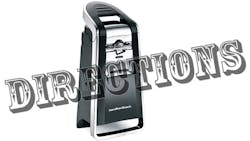I like to play with the latest technology and gadgets. I can usually get by without reading the documentation since one item typically works like another. Of course, more often these days that documentation may not be with the device or app but found somewhere online instead. You might be lucky enough to have a URL to begin this search.
The challenge is that even simple or relatively common items may not work the way you expect. I ran into this using the Hamilton Beach Smooth Touch can opener (see figure). Actually, I did not buy it but was asked why it did not work.
The Hamilton Beach Smooth Touch can opener actually takes the top of the can apart from the bottom instead of cutting out the center.
At first I could not figure it out. I have had automatic can openers before and they operated like the manual ones. The problem was, this one does not have the cutter to remove the center of the can lid. It actually breaks the seal between the can top and the can itself. It does not always work and some cans take a little more effort to open than others. It is nice because it does not leave a sharp edge like the cutter approach does.
There was actually a printed manual with this device. It actually was not a lot of help initially since it just ran through the operational procedure but didn't mention it did not cut the top open.
I had a little more of a challenge with a dev kit I had from Atmel. That had nothing but the hardware in the box. There was not even a paper with a URL on it. Of course, going to the website delivered the requisite tools and downloadable documentation.
Another challenge I had lately was Windows 8 (see Windows 8 Goes Far Beyond The Typical Operating-System Update). You have probably heard about its new interface that is more amenable to touch screens than mousing.
It can be confusing to use Windows 8 without the documenation especially for one that has been using Windows 7 since it was released. Windows 8 is actually easy to use but getting someone started with it is as challenging as getting someone to use the mouse with earlier versions of Windows. I've had to show people how to use Windows that never used a computer before. It was as challenging as training someone to use Windows 8 that had used Windows Vista.
Windows 8 has some really nice features once you figure out what is going on. Live tiles provides an active desktop that many like and some find unnerving. What I find a challenge is figuring whether a live tile can be configured to do what I want versus its default configuration.
I'll leave comments about Visual Studio to another blog entry. I recently started using it again and was pleasently surprised but in the same boat as using the latest Microsoft Office. There are a tremendous number of functions I am not taking advantage of yet because I don't know about most of them.
I now have the can opener at home. It was easier to get a more conventional replacement than explaining how and when the new one would work. On the software side, if they could get by with existing applications then sticking with an older operating system made more sense. Unfortunately new applications often do not run on old platforms and old applications often do not run on new operating systems.
Personally I keep virtual machines with older operating systems around to address these issues but it is not something I would like to train someone else to use. Virtual machines are nice but their interface sucks. It is what happens when techies create for techies and then need to have mere mortals use the software.
I still need to play around with Windows 8 on a tablet since I don't have one yet. I did notice that it was a lot like using an Apple iPad with its single button. That's a bit different than the Android tablets I am used to. In the meantime, I'll muddle through and hope to find some documentation somewhere that might help.
About the Author
William Wong Blog
Senior Content Director
Bill's latest articles are listed on this author page, William G. Wong.
Bill Wong covers Digital, Embedded, Systems and Software topics at Electronic Design. He writes a number of columns, including Lab Bench and alt.embedded, plus Bill's Workbench hands-on column. Bill is a Georgia Tech alumni with a B.S in Electrical Engineering and a master's degree in computer science for Rutgers, The State University of New Jersey.
He has written a dozen books and was the first Director of PC Labs at PC Magazine. He has worked in the computer and publication industry for almost 40 years and has been with Electronic Design since 2000. He helps run the Mercer Science and Engineering Fair in Mercer County, NJ.
- Check out more articles by Bill Wong on Electronic Design
- Bill Wong on Facebook
- @AltEmbedded on Twitter

